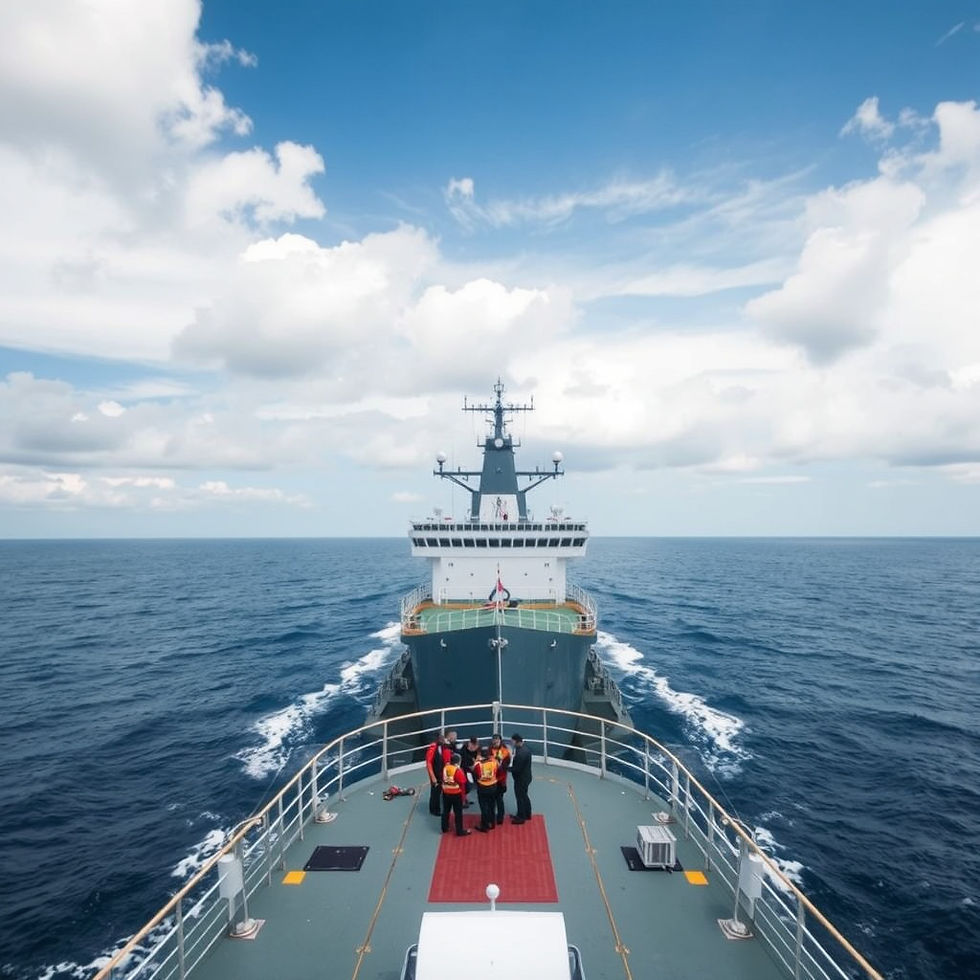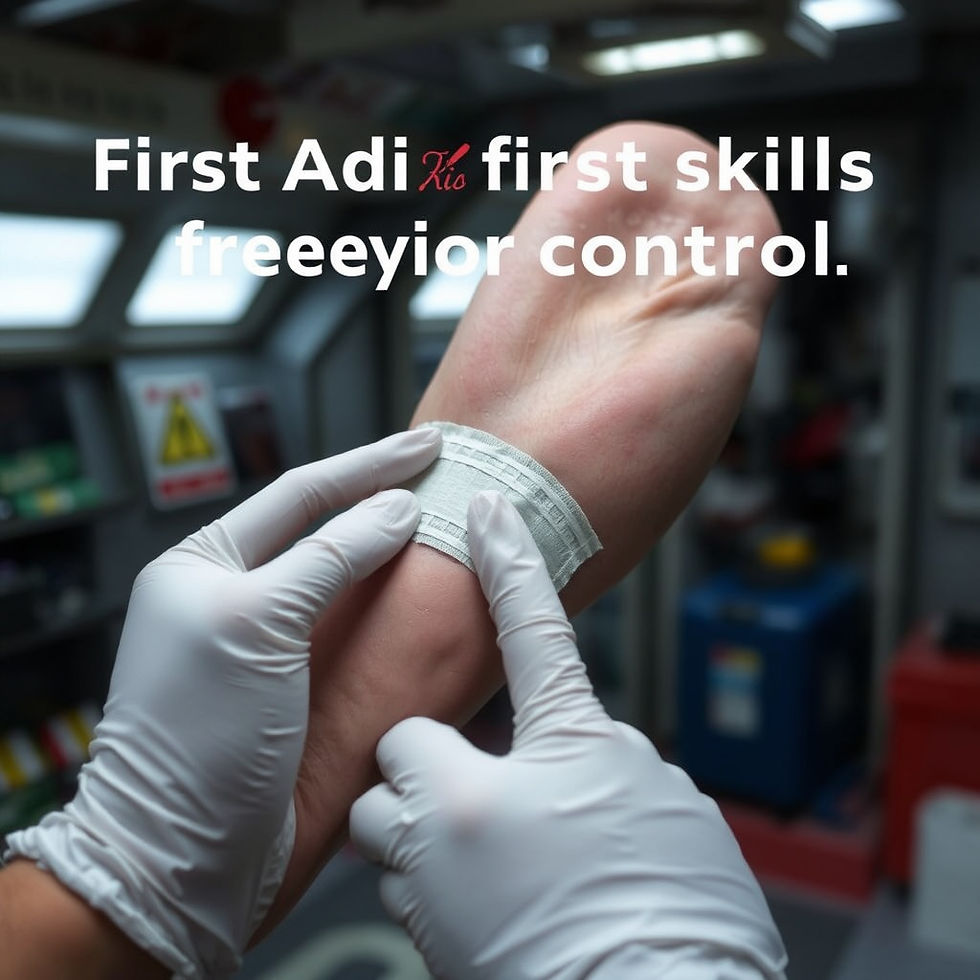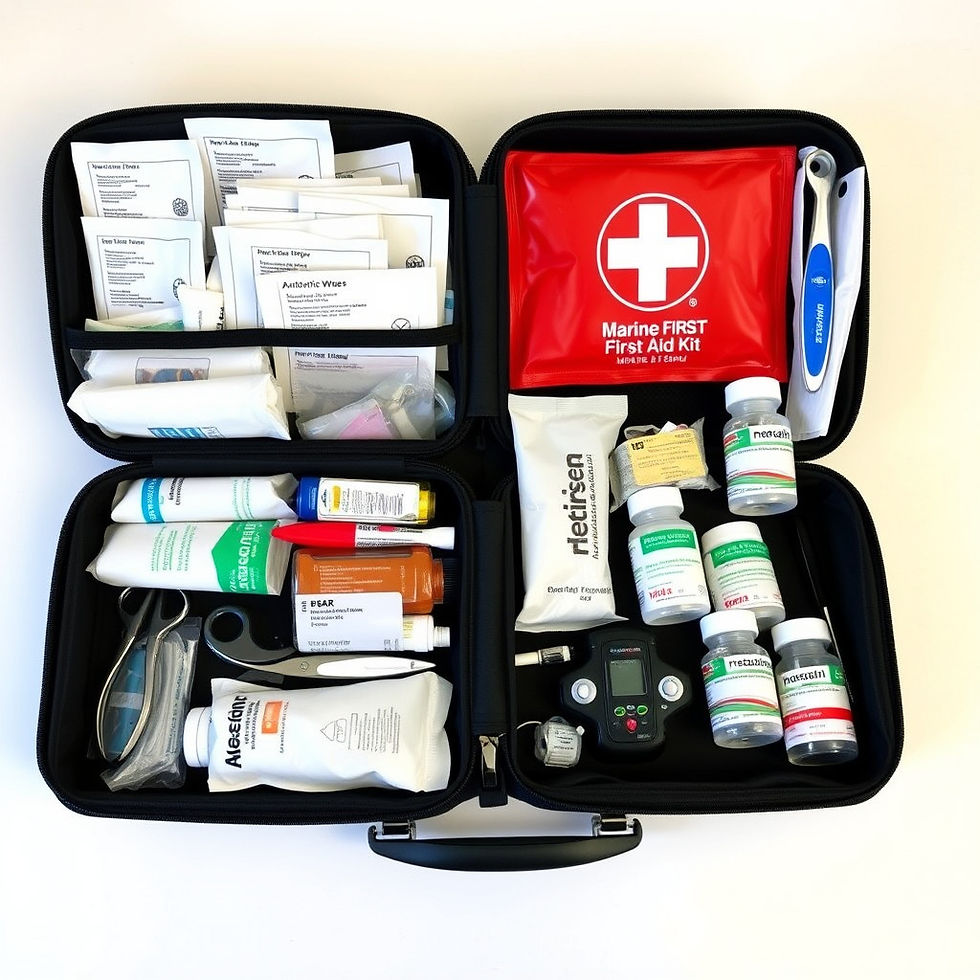🚢 First Aid on Ships: Essential Skills for Handling Medical Emergencies at Sea
- kousik pattanayak

- Jun 12
- 5 min read
Updated: Aug 4
🌊 Why First Aid is Critical for Seafarers
Life at sea comes with unique and unpredictable challenges. When professional medical help is hours or even days away, a medical emergency on a ship can quickly turn into a life-threatening situation. From a minor cut to a severe injury, knowing first aid can literally mean the difference between survival and tragedy.
In this essential guide, we'll dive deep into:
Common medical emergencies aboard ships
Must-have first aid skills for every seafarer
How to best prepare for medical situations when far from shore

🚨 Common Medical Emergencies You Might Face at Sea
Ships operate in isolated environments, making immediate medical response absolutely vital. Crew members need to be ready for various health incidents. Here are some of the most frequent emergencies encountered at sea:
1️⃣ Seasickness & Motion Sickness
Symptoms: Nausea, dizziness, vomiting, fatigue.
First Aid: Advise the person to lie down, focus on the horizon, and take anti-nausea medication if available. Ensure they get fresh air.
2️⃣ Respiratory Issues (Asthma, Breathing Difficulty)
Symptoms: Shortness of breath, wheezing, coughing, chest tightness.
First Aid: Help the person use their prescribed inhaler. Assist them into an upright, comfortable position. Ensure adequate ventilation and provide reassurance.
3️⃣ Cuts, Wounds & Bleeding
Symptoms: Open wounds, lacerations, puncture wounds, excessive blood loss.
First Aid: Apply direct pressure to the wound with a clean cloth or sterile gauze. Clean the wound thoroughly with antiseptic wipes. Bandage securely. For severe bleeding, elevate the injured limb if possible.
4️⃣ Burns & Scalds
Causes: Contact with hot surfaces, steam, boiling liquids, or chemicals.
First Aid: Immediately cool the burn under running cold water for at least 10-20 minutes. Cover the cooled burn with a sterile dressing. Avoid applying any ointments, butter, or home remedies.
5️⃣ Heart Attacks & Cardiac Arrest
Symptoms: Severe chest pain spreading to arms, neck, jaw, or back; difficulty breathing; sweating; sudden collapse and unconsciousness.
First Aid: If conscious, help the person into a comfortable position. If unconscious and not breathing normally, begin CPR (Cardiopulmonary Resuscitation) immediately. Use an onboard automated external defibrillator (AED) if one is available and you're trained.
6️⃣ Electrocution
Causes: Contact with faulty wiring, damaged electrical equipment, or wet conditions around electrical sources.
First Aid: First, ensure your own safety! Turn off the power source immediately. If the person is unresponsive and not breathing, perform CPR. Monitor for burns.
7️⃣ Food Poisoning & Allergic Reactions
Symptoms (Food Poisoning): Vomiting, diarrhea, abdominal cramps, fever.
Symptoms (Allergic Reactions): Skin rash, swelling (especially face/throat), difficulty breathing, dizziness.
First Aid (Food Poisoning): Provide plenty of fluids to prevent dehydration. Administer anti-diarrhea medication if appropriate.
First Aid (Allergic Reactions): For mild reactions, administer antihistamines. For severe reactions (anaphylaxis), seek immediate medical advice and use an auto-injector (e.g., EpiPen) if prescribed and available.
8️⃣ Fractures & Sprains
Causes: Slips, falls, heavy machinery accidents, sudden twists or impacts.
First Aid: Immobilize the affected area using splints or bandages to prevent further movement. Apply ice packs to reduce swelling. Seek professional medical help as soon as possible for severe or suspected fractures.

🏥 Essential First Aid Skills Every Seafarer Needs
Every crew member should be well-versed in basic first aid techniques to effectively manage emergencies. These are the must-know first aid skills that can be life-saving:
✅ CPR (Cardiopulmonary Resuscitation)
Compressions: Deliver chest compressions at a rate of 100–120 per minute, about 5–6 cm (2-2.4 inches) deep.
Breaths: Give 2 rescue breaths after every 30 compressions.
Continue: Perform continuously until the casualty recovers signs of life or professional medical help arrives.
✅ Bleeding Control
Direct Pressure: Apply firm, direct pressure to the wound using a clean pad or cloth.
Elevation: Elevate the injured limb above the heart if there are no signs of a fracture.
Dressings: Use sterile gauze and bandages to cover and secure the wound after bleeding is controlled.
✅ Burn Treatment
Cool the Burn: Immediately immerse the burned area in cool (not ice-cold) water for at least 10 minutes.
Cover: Gently cover the burn with a loose, sterile dressing or cling film. Do not pop blisters or apply creams/ointments.
Monitor: Watch for signs of infection, pain, or shock.
✅ Choking Response (Heimlich Maneuver)
Back Blows: Give up to 5 sharp back blows between the shoulder blades.
Abdominal Thrusts: If back blows don't clear the airway, perform abdominal thrusts (Heimlich maneuver).
Alternate: Continue alternating between back blows and abdominal thrusts until the obstruction is expelled or the person becomes unresponsive.
✅ Fracture & Sprain Management
Immobilization: Carefully immobilize the injured area using splints (e.g., rolled newspapers, rigid boards) and bandages to prevent movement.
RICE Method: Apply Rest, Ice, Compression (gentle bandaging), and Elevation for sprains and suspected fractures.
Seek Medical Help: Arrange for medical assessment as soon as possible, especially for severe fractures.
✅ Shock Management
Positioning: Lay the person down on their back and, if possible, elevate their legs about 12 inches above their head.
Keep Warm: Cover them with blankets or coats to prevent chilling.
Monitor: Continuously monitor their breathing, pulse, and level of consciousness. Loosen tight clothing.

🛠️ Essential First Aid Kit for Ships
A well-stocked and regularly checked marine first aid kit is non-negotiable for handling emergencies effectively. Here’s a checklist of what every ship should carry, beyond basic regulatory requirements:
Item | Purpose |
Adhesive bandages (various sizes) | Minor cuts & scrapes |
Sterile gauze pads & rolls | Dressing larger wounds, severe bleeding |
Antiseptic wipes & solution | Cleaning wounds, preventing infection |
Medical adhesive tape | Securing dressings, splints |
Tweezers & Scissors | Removing splinters, cutting bandages |
Digital thermometer | Monitoring body temperature |
Instant cold packs | Reducing swelling & pain (sprains/fractures) |
CPR face mask/shield | Safe resuscitation |
Pain relievers (e.g., ibuprofen, paracetamol) | Managing mild to moderate pain |
Burn cream/gel & dressings | Treating minor burns |
Antihistamines | Allergy relief (mild to moderate) |
Motion sickness medication | Preventing seasickness |
Eye wash solution | Flushing eyes from irritants |
Disposable gloves | Personal protection, hygiene |
Trauma shears | Cutting clothing around injuries |
Splints (e.g., SAM splint) | Immobilizing fractures/sprains |
Emergency blanket | Treating shock, keeping warm |
Resuscitation bag (BVM) | Assisting breathing (advanced) |

🚢 Preparing for Medical Emergencies When Far From Shore
Beyond the first aid kit, proactive measures are key to maritime safety.
🔹 Continuous Training & Drills
Every crew member should undergo mandatory STCW Basic First Aid Training and refresher courses.
Regular medical emergency drills are crucial to improve response times, test procedures, and ensure everyone knows their role.
🔹 Telemedical Assistance
Ships should have reliable access to remote medical consultation services (telemedicine). This allows qualified doctors onshore to guide first responders through complex medical situations.
Emergency evacuation plans for severe cases must be clearly defined, regularly reviewed, and ready for immediate implementation.
🔹 Robust Safety Protocols
Implement clear proper signage for emergency exits, muster points, and the location of medical kits and equipment.
Ensure regular maintenance and calibration of all onboard medical equipment, including AEDs and oxygen cylinders.
Maintain clear communication channels and chain of command for medical emergencies.
🔚 Conclusion
First aid skills are absolutely critical for seafarers. They ensure a quick and effective response to medical emergencies at sea, often in situations where professional medical help is far away. By staying prepared, maintaining a well-stocked and accessible first aid kit, and undergoing proper, continuous training, crew members are empowered to save lives, prevent complications, and maintain safety onboard.
Stay vigilant, stay prepared, and ensure every voyage is a safe one.
🚢 Have you ever faced a medical emergency at sea? Share your experience or any valuable first aid tips in the comments below!
📢 If you found this guide helpful, please like, share, and subscribe for more maritime safety tips and essential seafarer knowledge!
Comments